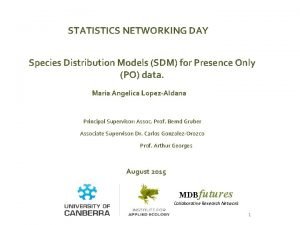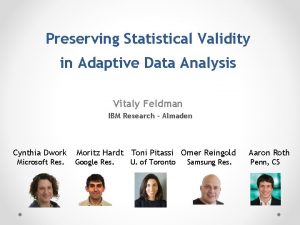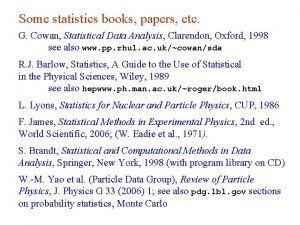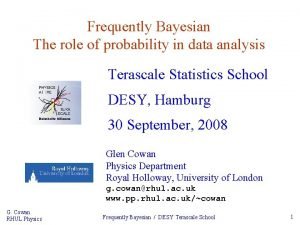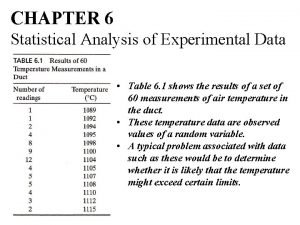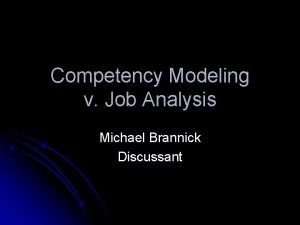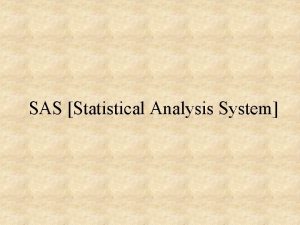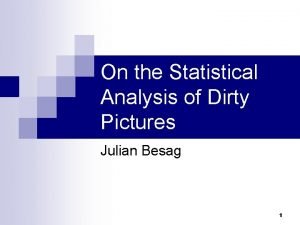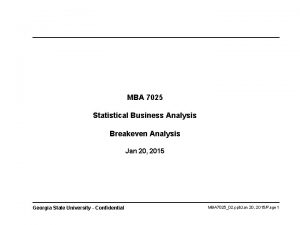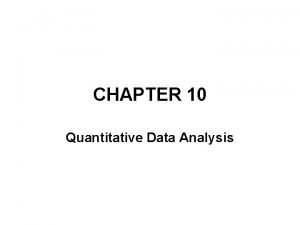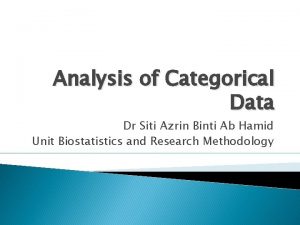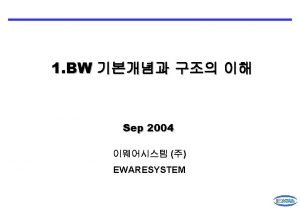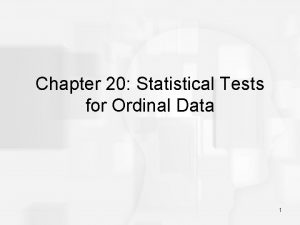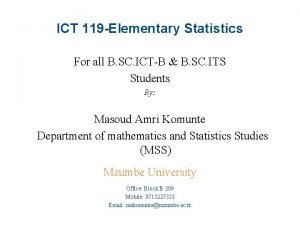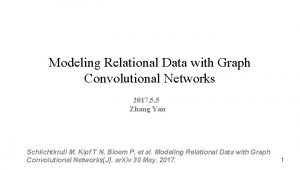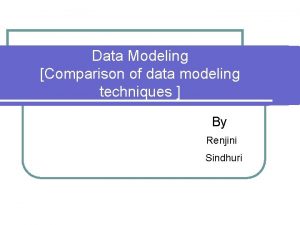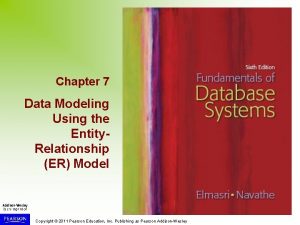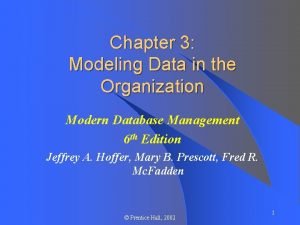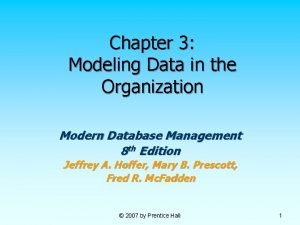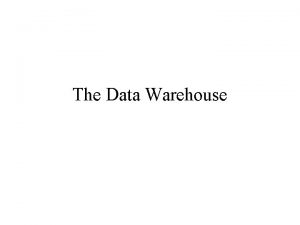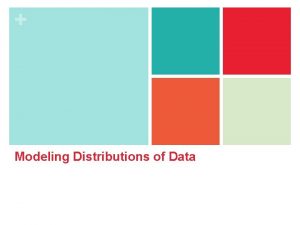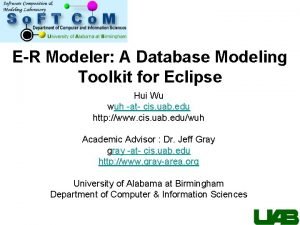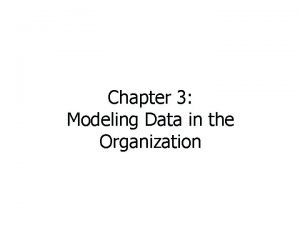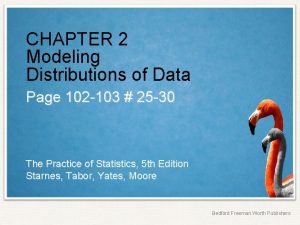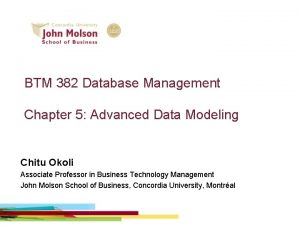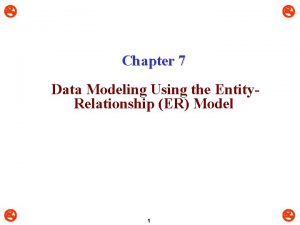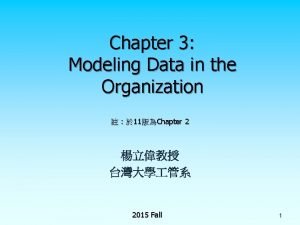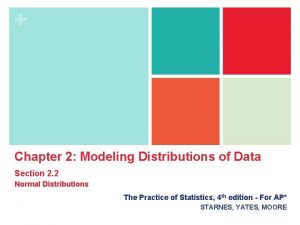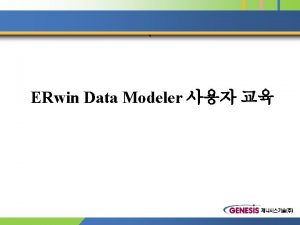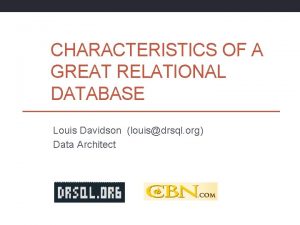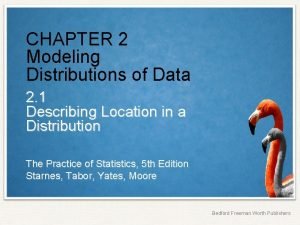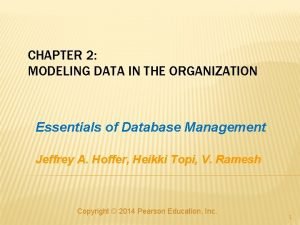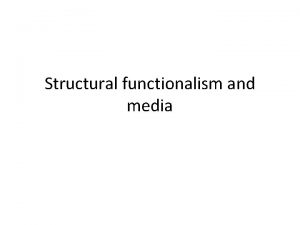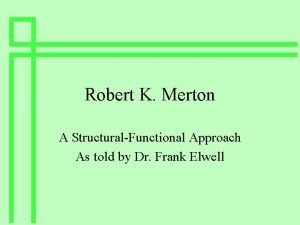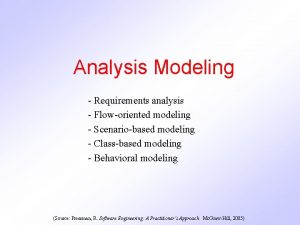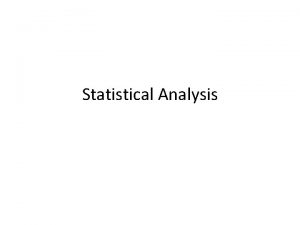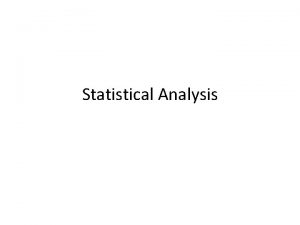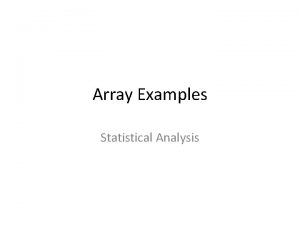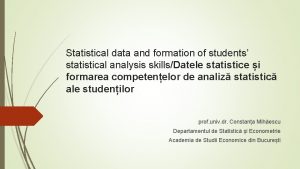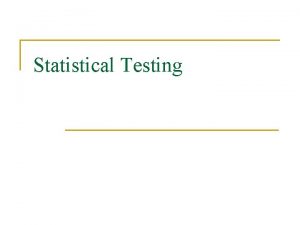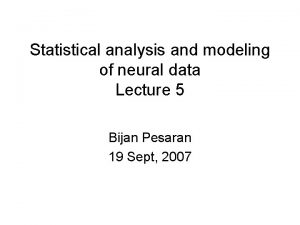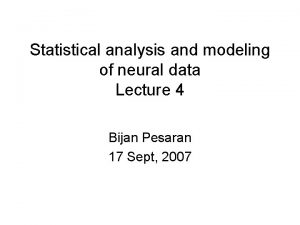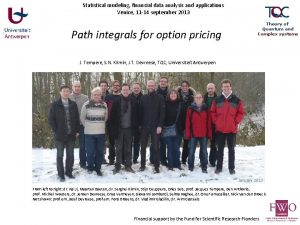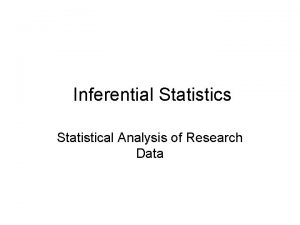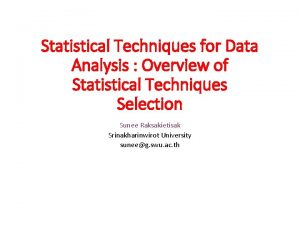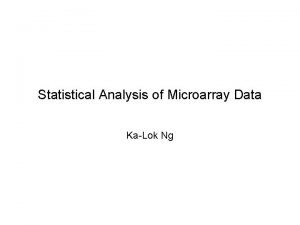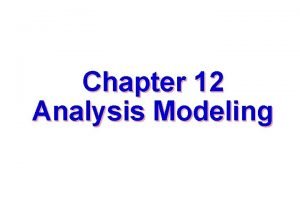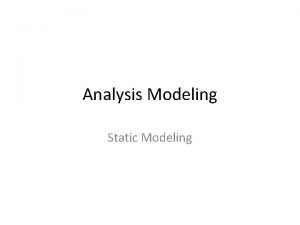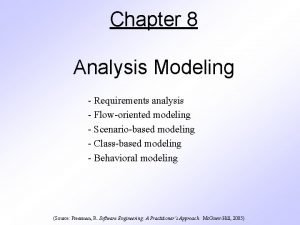Statistical Modeling and Data Analysis Given a data

























































- Slides: 57

Statistical Modeling and Data Analysis Given a data set, first question a statistician ask is, “What is the statistical model to this data? ” We then characterize and analyze the parameters of the model with an objective in mind. • Example : SBP of Cancer Patients vs. Normal patients Cancer: 145, 165, 134, 120, 112, 156, 145, 133, 135, 120 Normal: 138, 120, 112, 110, 128, 134, 128, 109, 138, 140 Objective: Do cancer patients have higher SBP than the normal patients? 1

Population of cancer patients with a probability distribution Population of normal patients with a probability distribution normal cancer Systolic blood pressure Does the data support this hypothesis? 2

3

4

5

6

7

8

Image Process: 9

10

The same can be said about weather map. 11

Data Analysis Generally speaking, we perform one or more of the following tasks in data analysis (statistical inference) • Estimate the model • Hypothesis testing • Predictive analysis Given the sample data, objective is to make inference about the population described by the probability model. All inferences are based on probability model assumed. 12

13

Sample …… -- -- observed observed …… -- -- 14

15

16

17

18

normal cancer Systolic blood pressure 19

20

21

22

23

Computation of the posterior There are two popular techniques of computing posterior distribution: 1. Metropolis-Hasting Algorithm 2. Gibbs Sampler These techniques can be used effectively for complex probability model and reasonable priors. 24

Frequentist vs. Bayesian Frequentist Bayesian All data information is contained in the likelihood function. All data information is contained in the likelihood function and the prior The estimates are viewed in terms of how they behave on the average Estimates are viewed in terms of where they are located in the posterior Estimates are generally obtained by maximizing the likelihood function. Techniques include Newton-Raphson, EM-algorithm Estimates are obtained from the posterior. Techniques include Gibbas Sampler, Metropolis-Hasting etc. 25

26

27

28

Analysis of Variance (ANOVA) ANOVA is one of the most popular statistical tools of analyzing data. Factor 1 Y Factor 2 A Response Variable Factor 3 Does Y (the response) depends on any of the factors? 29

Example 1: You are doing a research on mpg (miles per gallon) for a brand of automobiles. Question: What effects mpg? Wind speed mpg Air temperature Air moisture Do wind speed, air temperature, and air moisture effect mpg? 30

Example 2: Research Question: Does blood pressure (BP) depend on weight and gender? Weight BP Gender 31

There is a variation in BP. Some is due to weight, and some is due to gender. BP * Female * Male * ** * * * * Weight 32

33

34

35

36

37

38

39

40

41

Multiple Hypotheses: Consider 1000 independent tests each at Type-error of α = 0. 05. Then 5% of the null hypotheses would be falsely rejected. In other words, if 50 of the hypotheses were rejected, there is no guarantee that they were not all falsely rejected. FWER: m = # of hypotheses π = P(One or more falsely rejected hypotheses) = 1 – (Bonferroni Correction)

If m is large, α would be very small. Thus the power of detecting any true positive would be very small. Sequential Bonferroni Corrections: Let be the p-values of independent tests with corresponding null hypotheses . Holm’s Method (Holm, 1979; Scand. Statist. ) • If , accept all nulls. • If , reject ; if , accept the rest of nulls. • Continue until first j such that . In that case reject all and accept the rest of nulls.

Simes Method (Biometrika, 1986): • If , reject all nulls. • If not, but if , reject all • Continue until first . In that case reject all Note: Both Holm’s and Simes methods are designed to refine the FWER.

False Discovery Rate (FDR): Benjamini and Hochberg (1995), JRSS When the number of hypotheses m is very large (say in thousands), and if each individual hypothesis is not important, then FWER criterion is not very useful since it yields few discoveries. For example, in a microarray data analysis, the objective is to detect potential genes for future exploration. Here, each individual gene is not important. In such cases, tests with a controlled FWER would yield few discoveries.

FDR = Expected proportion of false rejections. Accept Null Reject Null True Null U V True Alternatives T S m- R R FDR = = Note that FWER = P(R>0) Total m

Benjamini and Hochberg proved that the following procedure produces : Let k be the largest integer i such that , then reject all The result was proved under the assumption of independent test statistics. It was later extended to a positively correlated test statistics by Benjamini and Yekutieli, 2001; Ann. Stat.

Bayesian Interpretation (Storey, 2003, Ann. Stat. ) are independently distributed. Note: p. FDR is a posterior version of the Type-I error

Directional Hypothesis Problem (Three decision problem): Suppose is rejected, but it is also important to find the direction of So the problem is to find subsets

Example: Gene selection When the genes are altered under adverse condition, such as cancer, the affected genes show under or over expression in a microarray. The objective is to find the genes with under expressions and genes with over expressions.

Directional Error (Type III error): Type III error is defined as P( Selection of false direction if the null is rejected). The traditional method does not control the directional error. For example, Sarkar and Zhou (2008, JSPI) Finner ( 1999, AS) Shaffer (2002, Psychological Methods) Lehmann (1952, AMS; 1957, AMS) Main points of these work is that if the objective is to find the true direction of the alternative after rejecting the null, then a Type III error must be controlled instead of Type I error.

Bayesian Decision Theoretic Framework




Bayes Rule

 Role modeling theory
Role modeling theory Statistical modeling
Statistical modeling Relational modeling vs dimensional modeling
Relational modeling vs dimensional modeling Preserving statistical validity in adaptive data analysis
Preserving statistical validity in adaptive data analysis Cowan statistical data analysis
Cowan statistical data analysis State bayes theorem
State bayes theorem Statistical analysis of experimental data
Statistical analysis of experimental data Best practices data warehousing
Best practices data warehousing Four model approach
Four model approach Typical process description tools include
Typical process description tools include Simulation modeling and analysis law kelton
Simulation modeling and analysis law kelton Process modeling in system analysis and design
Process modeling in system analysis and design System requirements checklist output example
System requirements checklist output example Competency modeling vs job analysis
Competency modeling vs job analysis Manufacturing systems modeling and analysis
Manufacturing systems modeling and analysis Job analysis in staffing
Job analysis in staffing Statistical analysis system
Statistical analysis system On the statistical analysis of dirty pictures
On the statistical analysis of dirty pictures Multivariate statistical analysis
Multivariate statistical analysis Statistical business analysis
Statistical business analysis Marketing analytics software r
Marketing analytics software r Data vault pros and cons
Data vault pros and cons Statistical treatment of data example
Statistical treatment of data example What statistical test for categorical data
What statistical test for categorical data Statistical data warehouse
Statistical data warehouse Statistical tests for ordinal data
Statistical tests for ordinal data Statistical treatment
Statistical treatment Modeling relational data with graph convolutional networks
Modeling relational data with graph convolutional networks Data modeling techniques
Data modeling techniques Data modeling using entity relationship model
Data modeling using entity relationship model Data warehouse modeling tutorial
Data warehouse modeling tutorial Modeling data in the organization
Modeling data in the organization Modeling data in the organization
Modeling data in the organization Qlik circular reference
Qlik circular reference Vhdl data flow modeling
Vhdl data flow modeling Oltp data model
Oltp data model Sinusoidal functions as mathematical models
Sinusoidal functions as mathematical models Modeling distributions of data
Modeling distributions of data Eclipse data modeling
Eclipse data modeling Dataflow verilog
Dataflow verilog Modeling data in the organization
Modeling data in the organization Chapter 2 modeling distributions of data
Chapter 2 modeling distributions of data Btm 382
Btm 382 Er model diagram
Er model diagram Modeling data in the organization
Modeling data in the organization Chapter 2 modeling distributions of data
Chapter 2 modeling distributions of data Cardinality constraints中文
Cardinality constraints中文 Data modelling
Data modelling Sql developer erd
Sql developer erd Louis davidson relational data modeling
Louis davidson relational data modeling Modeling distributions of data
Modeling distributions of data Modeling data in the organization
Modeling data in the organization Data modeling fundamentals
Data modeling fundamentals Structural functional analysis is given by
Structural functional analysis is given by Merton
Merton Structural functional analysis is given by
Structural functional analysis is given by Find vo using mesh analysis
Find vo using mesh analysis Linear quadratic function
Linear quadratic function

